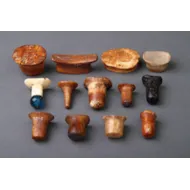Collection of Bering Sea Eskimo Inuit Male and Female Labrets ‘Tuutat’
A Collection of Bering Sea Eskimo Inuit Male and Female Labrets ‘Tuutat’
Carved from walrus ivory, stone and jet, one with a blue glass trade bead
18th and 19th Century
Sizes: 2.5cm high (max) 1cm high (min) 4cm wide (max)
1 ins high (max) ¼ ins high (min) 1½ ins wide (max)
Carved from walrus ivory, stone and jet, one with a blue glass trade bead
18th and 19th Century
Sizes: 2.5cm high (max) 1cm high (min) 4cm wide (max)
1 ins high (max) ¼ ins high (min) 1½ ins wide (max)
Labrets such as these have been used in the Bering Strait for over 1000 years. Men usually wore labrets beneath the corners of their mouths whilst women wore a single labret beneath their lower lip. The shapes of men’s labrets vary with the age of the wearer and with regional styles, most usually a variation on round, square or oval shapes. Boys wore small ones and labrets decorated with valuable blue glass trade beads were worn by Point Hope and Point Barrow men. Generally labrets were shaped with a flange that rested on the inside of the lip and was held in place by pressure from the teeth. The cuts were made during puberty, but there was no formal ceremony, or rite of passage involved.
When travelling long distances in cold weather, men would remove large labrets from their cheeks to avoid suffering frostbite conducted through the plug. They would reinsert the labrets to appear as well-dressed guests when they entered the ‘gasgig’. It is said that men wearing labrets resemble walrus with their tusks projecting from the corners of their mouths. Certainly, labrets were symbols of maturity and social status, with the largest ones reserved for those of high rank and distinction.
When travelling long distances in cold weather, men would remove large labrets from their cheeks to avoid suffering frostbite conducted through the plug. They would reinsert the labrets to appear as well-dressed guests when they entered the ‘gasgig’. It is said that men wearing labrets resemble walrus with their tusks projecting from the corners of their mouths. Certainly, labrets were symbols of maturity and social status, with the largest ones reserved for those of high rank and distinction.
Collection of Bering Sea Eskimo Inuit Male and Female Labrets ‘Tuutat’

SOLD
